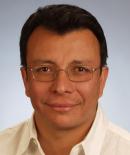
Alfredo Franco-Obregon
Laboratory of Biosensors and Bioeletronics
Institute for Biomedical Engineering, Switzerland
Dr. Franco Obregon received his PhD in the Neurosciences from the University of California at San Francisco in 1991. Currently, he holds a position as group leader of the Mechanobiology Laboratory as well as Senior Scientist in the Space Biology group and Laboratory of Biosensors and Bioelectronics of the Swiss Federal Institute of Technology ETH in Zurich, Switzerland. Dr. Franco Obregon also administers the flow cytometry laboratory of the ETH and University of Zurich.
Dr. Franco-Obregon′s scientific focus is understanding how tissue development is modulated by mechanical stimuli. Most tissues modulate their developmental programs to match the mechanical stresses present in the behaving organism. These include gravitational forces, tensile strains arising from the elongation of bones, compressive forces within joints, or dynamic mechanical stimulation resulting from muscular activity. The most notable examples of such tissues are skeletal, cardiac and smooth muscles, bone, cartilage, tendons and blood vessels. In fact, developmental programs that are regulated by mechanical stimuli are the rule, rather than the exception, giving rise to greater than 80% of our entire body mass. Moreover, forms of cell behavior such as migration, axonal outgrowth, blood clotting and extracellular matrix deposition are also regulated by mechanical stimuli. Indeed, most cells require some form of mechanotransduction to survive. Mechanosensitive developmental programs are thus ubiquitous, ongoing and of great clinical importance. In particular, I am interested in those mechanotransductive developmental processes that impinge on cellular calcium homeostasis. Calcium regulates pivotal processes such as cellular communication, differentiation, growth and survival. Not surprisingly, a breakdown in cellular calcium homoeostasis results in devastating developmental abnormalities. Mechanically-gated calcium channels are the ideal molecular entities to translate mechanical stimuli into a calcium response that then regulates key enzymatic and genetic cascades involved in complex tissue development. Understanding how the cell translates the entry, sequestration and release of calcium from intracellular stores into a developmental response will lead to the development of more effective therapeutic strategies aimed at reversing trauma- and age-related cellular degeneration.
Biosensors & Bioelectronics received 6207 citations as per Google Scholar report